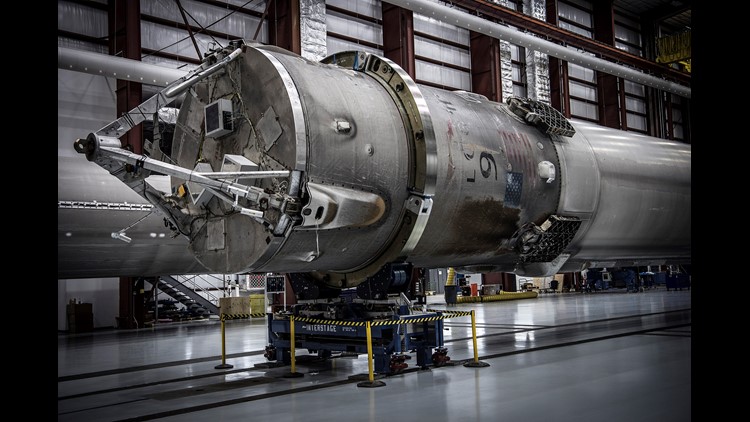![Video: SpaceX launches Falcon 9, lands first stage [video : 84010602]](http://bcdownload.gannett.edgesuite.net/brevard/38321750001/201605/1111/38321750001_4880296603001_video-still-for-video-4880748351001.jpg?pubId=38321750001)
![spacex-booster-051716 [image : 84479776]](http://www.gannett-cdn.com/media/2016/05/17/USATODAY/USATODAY/635990648195496595-spacex-booster-051716.jpg)
MELBOURNE, Fla. — Half-a-mile above its landing target early May 6, a SpaceX rocket booster slammed on the brakes, firing three engines to cut its speed by more than 300 mph in three seconds.
The Falcon 9 rocket’s first stage then touched down gently in darkness on the deck of a ship in the Atlantic Ocean, completing a high-speed, 75-mile drop.
The sea landing showed SpaceX can recover boosters intact from some of its most challenging launches, but the rocket’s searing return from space took a toll.
CEO Elon Musk indicated the rocket stage may not be in shape to launch again, but will help the company assess the flight-worthiness of boosters recovered in the future.
![SpaceX rocket blasts off from Cape Canaveral [oembed : 84479748] [oembed : 84479748] [oembed : 84479748] [oembed : 84479748]](/Portals/_default/Skins/PrestoLegacy/CommonCss/images/smartembed.png)
“Most recent rocket took max damage, due to (very) high entry velocity,” Musk said on Twitter. “Will be our life leader for ground tests to confirm others are good.”
![Most recent rocket took max damage, due to v high entry velocity. Will be our li [oembed : 84479754] [oembed : 84479754] [oembed : 84479754] [oembed : 84479754]](/Portals/_default/Skins/PrestoLegacy/CommonCss/images/smartembed.png)
SpaceX on Saturday moved the 14-story Falcon 9 booster — charred gray and black along most of its length — to a hangar at Kennedy Space Center’s pad 39A, where it joined two other landed stages.
"Three's company," said Musk.
![Three#39;s company pic.twitter.com/nRfFmTpzZwmdash; Elon Musk (@elonmusk) May 15 [oembed : 84479758] [oembed : 84479758] [oembed : 84479758] [oembed : 84479758]](/Portals/_default/Skins/PrestoLegacy/CommonCss/images/smartembed.png)
Those first two recovered stages were missions flown to low orbits that offered more benign landing conditions. The one launched May 6 delivered a Japanese communications satellite, JCSAT-14, to an orbit more than 22,000 miles above the equator, requiring more speed.
The booster was traveling more than 5,200 mph when it separated from the rocket's upper stage, compared to about 4,000 mph during the previous mission to a lower orbit, and SpaceX said it experienced five times as much heating during its re-entry through the atmosphere.
With the booster coming in "faster and hotter," as Musk put it, the company had warned that a successful landing was unlikely. It landed within six feet of its target.
![SpaceX Dragon splashes down on Earth with space station cargo [oembed : 84479800] [oembed : 84479800] [oembed : 84479800] [oembed : 84479800]](/Portals/_default/Skins/PrestoLegacy/CommonCss/images/smartembed.png)
![Photos: SpaceX launch from Cape Canaveral with JCSAT-14 [gallery : 84010756]](http://www.gannett-cdn.com/-mm-/fc40e024c8e40283b00ecd061643784eb6469193/c=0-185-2586-2395/local/-/media/2016/05/06/Brevard/Brevard/635980985788699169-SPACEX-FALCON-9-LAUNCH-CR-80079.jpg)
Now the question is whether tweaks to heat shielding and perhaps other systems can harden the rocket so it can withstand such severe forces in good enough condition to fly again without extensive refurbishment. Quick and easy turnarounds are the key to making reusable rockets a game-changer that dramatically lowers launch costs, SpaceX has repeatedly said.
SpaceX hopes to re-fly its first rocket, the one it launched in April, later this year.
The company’s next mission, targeted for May 26, will look much like the last one: A Falcon 9 aims to launch the Thaicom 8 communications satellite from Cape Canaveral and attempt another booster landing at sea.
Two more launches could follow in June, of another communications satellite and of International Space Station cargo.
Follow James Dean on Twitter: @flatoday_jdean



